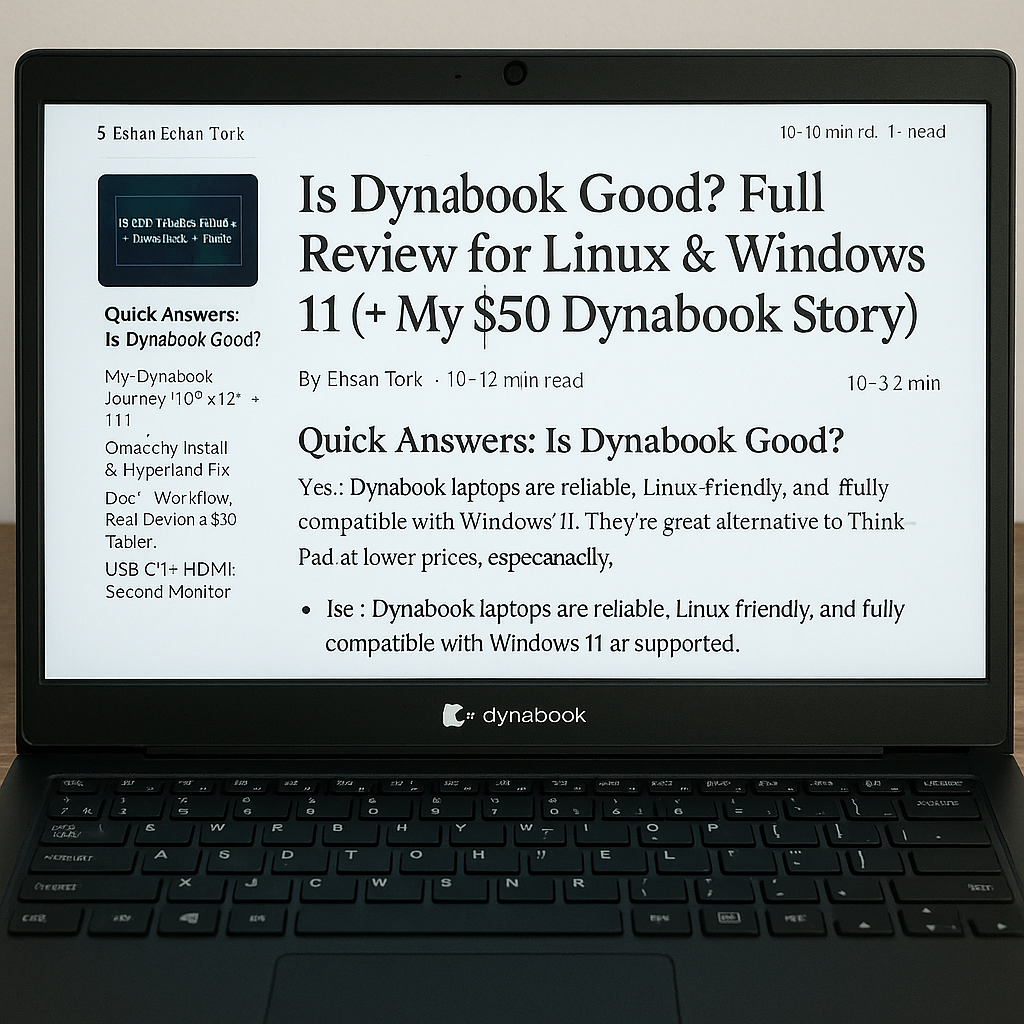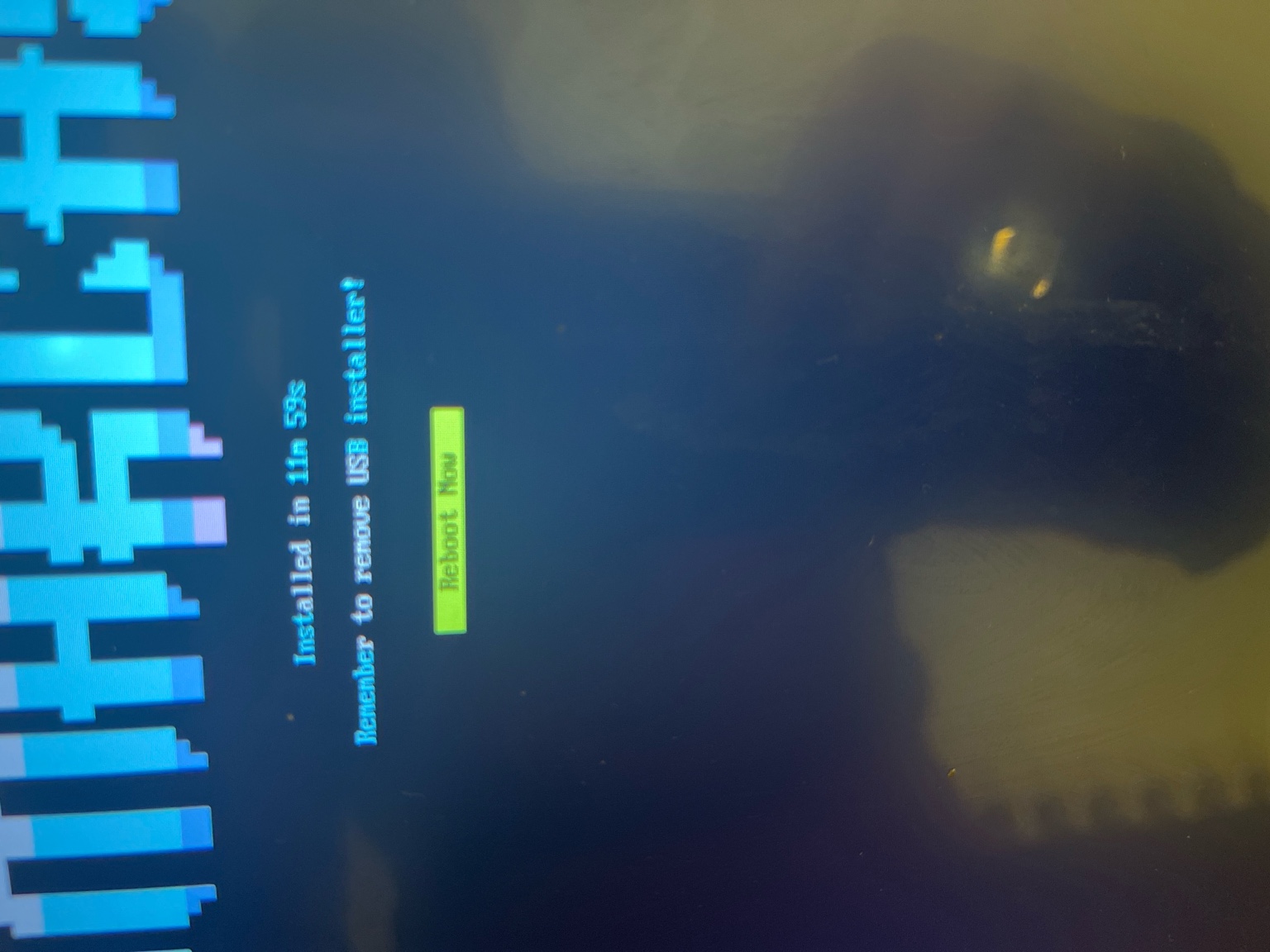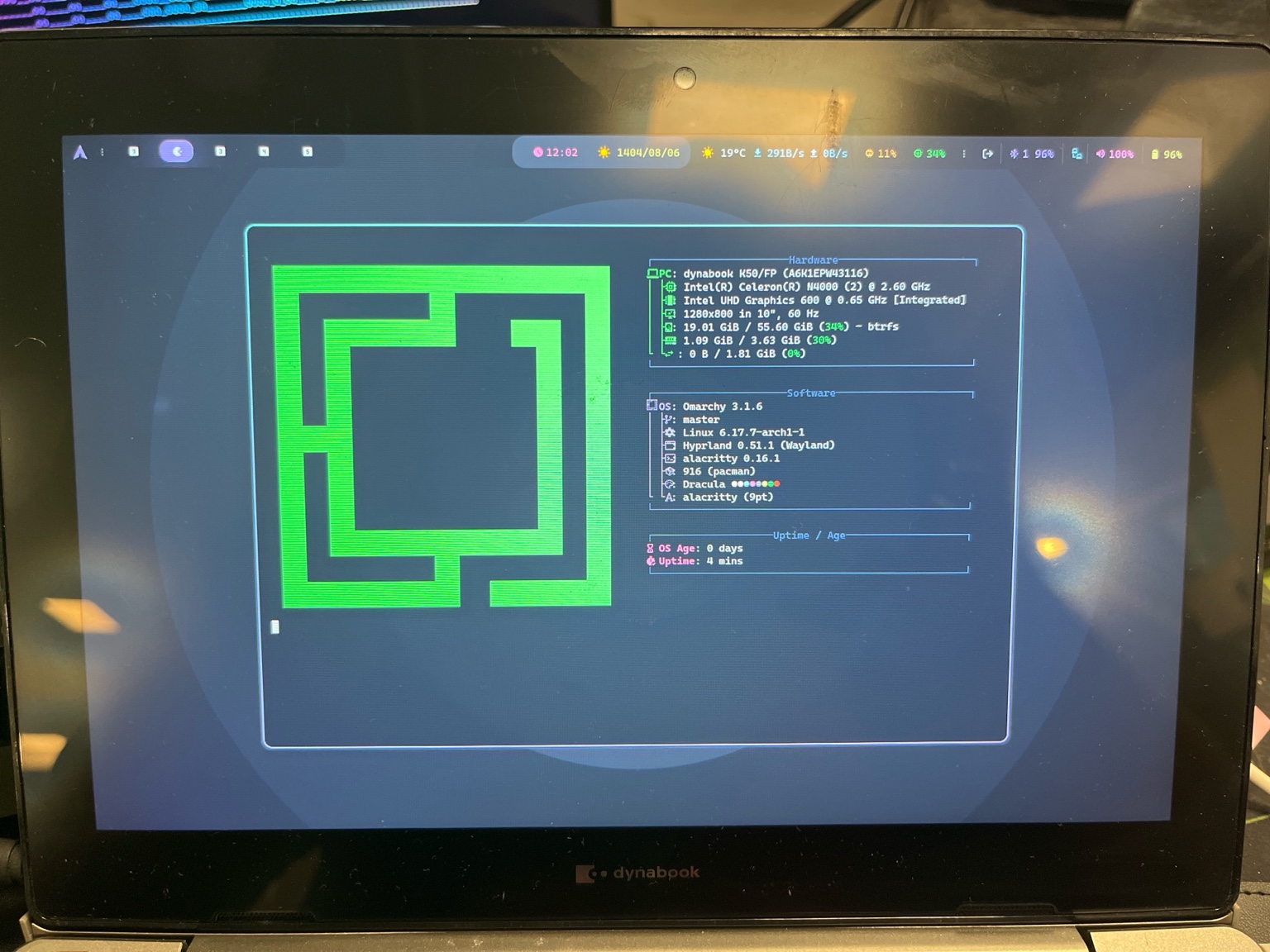Is Dynabook Good? Full Review for Linux & Windows 11 (+ My $50 Dynabook Story)

Quick Answers: Is Dynabook Good?
Yes. Dynabook laptops are reliable, Linux-friendly, and fully compatible with Windows 11. They're a great alternative to ThinkPad at lower prices, especially on the used market.
- Is Dynabook good for Linux? Yes—Wi-Fi, audio, touch, rotation, suspend, and USB-C video worked across my devices.
- Is Dynabook good for Windows 11? Yes—TPM 2.0, Secure Boot, drivers, and firmware updates are supported.
Why I Became a Dynabook User
Most laptop brands today feel identical—same plastic feeling, same mediocre build, same compromises. But after testing several Dynabook devices, I realized something surprising:
💡 Dynabook still carries the true Japanese engineering mindset.
From 10-inch tablets to 12-inch convertibles and 14-inch ultrabooks, they all share the same philosophy: strong build, stability, practicality, reliability, and zero drama on Linux.
Now I own three Dynabooks in three sizes, each serving a different purpose—and all shockingly good. Let me explain why.
My Dynabook Journey: From Compact to Powerhouse
12″ Dynabook R82/B — The Linux Warrior That Started It All
My first Dynabook was the R82/B, a perfect 12″ convertible that changed my perspective on what a portable development machine should be:
- Intel Core m CPU — Silent, cool, and surprisingly capable
- 4 GB RAM — Enough for focused development work
- 256 GB SSD — Fast, reliable storage
- 1080p touchscreen — Sharp and responsive
- Great battery life — All-day coding sessions
- Solid magnesium chassis — Feels premium, not plastic
I installed Arch + Hyperland (using my Omarchy profile) and… everything just worked.
✅ Touchscreen perfectly calibrated
✅ Rotation sensors detected instantly
✅ Keyboard and touchpad flawless
✅ Wi-Fi and Bluetooth stable
✅ Sleep/wake cycles rock solid
✅ Zero weird bugs or driver hunting
It feels like a ThinkPad X series, just thinner and more lightweight. The convertible form factor makes it perfect for reading documentation in tablet mode, then flipping back to laptop mode for coding. This is when I realized: Dynabook gets it.
10″ Dynabook B45/K50 — The $50 Miracle Tablet
Then I found a 10″ Dynabook tablet for just $50. Skeptical but curious, I grabbed it. The specs looked modest:
- Celeron N4000 — Dual-core, 1.1 GHz base, 2.6 GHz burst
- 4 GB RAM — Soldered but adequate
- 64 GB replaceable eMMC — User-upgradeable storage (!)
- Full HD touch screen — 1920×1080 on 10 inches is crisp
- USB-C video output — DisplayPort alt mode works perfectly
But here's where I got shocked: this Celeron N4000 absolutely destroys Atom x5 tablets.
The eMMC inside is much faster than the cheap storage in Lenovo Miix 320 or HP Stream tablets. The SSD-like speed feels close to SATA performance. The CPU is roughly 3× faster than Atom x5 in real-world usage:
- Chrome finally runs smoothly with multiple tabs
- DevTools are responsive, not sluggish
- Editors (Zed, Cursor) launch instantly
- Terminal emulators feel native, not laggy
- Hyperland compositor runs perfectly after one config line
For $50, this tablet performs like a miniature laptop, not a toy. It's become my coffee shop companion and travel machine.
14″ Dynabook X40J — The All-Metal Beast
After selling my MacBook Pro 2017 (which was thermal throttling under Linux workloads), I invested in a Dynabook X40J. This is where Dynabook shows its true premium engineering:
- Intel Core i7-1165G7 — 11th Gen Tiger Lake, 4 cores, 8 threads
- 16 GB RAM — Perfect for Docker, VMs, and heavy IDEs
- Full magnesium/aluminum chassis — Zero flex, zero creaks
- MIL-STD-810G certified — Military-grade durability testing
- Only 1.4 kg — Lighter than most 14″ laptops
- Excellent port selection — USB-A, USB-C, HDMI, Ethernet, SD card
- Windows 11 Pro support — TPM 2.0, Secure Boot ready
- ThinkPad-level battery life — 8-10 hours of real development work
Running CachyOS with kernel optimizations and my performance tweaks, the benchmarks are impressive:
- Geekbench single-core: ~1920
- Geekbench multi-core: ~5000+
This is very close to my office ThinkPad T14 Gen3 performance. The thermal management is excellent—sustained workloads don't cause throttling like the MacBook did. Linux runs perfectly out of the box, just like ThinkPad.
The build quality is stunning. The magnesium-aluminum alloy chassis feels solid and premium. The keyboard has excellent travel and tactile feedback. The screen hinge is perfectly balanced—opens with one hand, stays put at any angle. This is Japanese precision engineering at its finest.
Omarchy Install & Hyperland Fix

Install times I measured:
- Dynabook N4000: ~12 min
- Core m5 tablet: ~11 min
- Lenovo Miix 320 (Atom x5): 22 min
- MacBook Pro 2017: 9 min
On first boot the cursor/touch was flipped in Hyperland. The fix was a single line:
no_hardware_cursors = trueAfter that, touch, rotation, and gestures were perfect.

Day-1 Workflow: Real Development on a $50 Tablet
I used the 10″ Dynabook all day for real work. Results:
- Apps launch instantly (big jump from Atom).
- Chrome finally smooth; DevTools responsive.
- Zed + Copilot, Warp terminal, and Cursor all ran great.
- NGINX locally with editor and browser → no lag.
- System stayed around ~1.1–1.3 GB RAM with Wayland.
USB-C → HDMI: Second Monitor Works
The 10″ model mirrored to an external 1080p display via USB-C to HDMI without issues. Dual-monitor coding on a $50 tablet is real.
Is Dynabook Good for Linux?
Yes. Absolutely. Zero drama.
I've tested Dynabook laptops across multiple distributions and desktop environments, and the experience has been exceptional:
Distributions Tested (All Working Perfectly)
- Arch Linux (my daily driver) — Full hardware support out of the box
- Manjaro — Zero configuration needed
- Fedora — Worked perfectly on first boot
- Ubuntu/Pop!_OS — Everything detected automatically
- CachyOS — Excellent performance with optimized kernels
Desktop Environments Tested
- KDE Plasma — Smooth, all features working ✅
- GNOME — Perfect touch gestures, scaling ✅
- Cinnamon — Stable and responsive ✅
- Hyperland (Wayland compositor) — Works after one config line ✅
- COSMIC (Pop!_OS's new DE) — Excellent experience ✅
Hardware Support (What Actually Works)
- ✅ Wi-Fi — Intel chipsets, instant recognition, stable connections
- ✅ Bluetooth — Pairing works flawlessly, no dropouts
- ✅ Audio — Speakers, headphones, HDMI audio all working
- ✅ Brightness keys — Fn+F6/F7 recognized immediately
- ✅ Volume keys — Fn+F8/F9/F10 perfect
- ✅ Touchscreen — Multi-touch, gestures, palm rejection excellent
- ✅ Rotation sensors — Auto-rotate on convertibles works perfectly
- ✅ Stylus/pen — Pressure sensitivity, tilt detection (on supported models)
- ✅ Suspend/resume — Rock solid, no wake issues
- ✅ Hibernation — Works reliably with proper swap configuration
- ✅ USB-C video output — DisplayPort alt mode, 4K@60Hz support
- ✅ Thunderbolt 4 (on X40J) — Full functionality, docking stations work
- ✅ Webcam — Detected immediately, works in all apps
- ✅ Fingerprint reader — Works with fprintd (though placement is awkward)
The Only "Issue" (Easy Fix)
On Hyperland (Wayland compositor), the cursor was initially flipped on touchscreen input. The fix was literally one line in ~/.config/hypr/hyprland.conf:
no_hardware_cursors = trueAfter that, touch, rotation, and gestures were absolutely perfect. This isn't a Dynabook issue—it's a common Wayland+touchscreen quirk that affects many laptops.
Function Keys Configuration
Some reviewers complain about Fn keys not working on Linux. This is distro-dependent, not hardware-dependent. Here's how to fix it:
- KDE Plasma: System Settings → Shortcuts → search for the function → press your Fn key → done
- GNOME: Settings → Keyboard Shortcuts → assign Fn keys manually
- Cinnamon: Keyboard settings → same process
- Hyperland: Edit
~/.config/hypr/keybinds.conf(or ask your AI coding assistant 😄)
Once configured, everything works exactly as expected. This is standard Linux desktop configuration, not a Dynabook problem.
Performance on Linux (Better Than Windows?)
Running CachyOS (Arch-based with performance optimizations) on my X40J, I see:
- Lower idle RAM usage: ~1.1-1.3 GB (Hyperland) vs ~3-4 GB (Windows 11)
- Faster boot times: ~8 seconds to desktop vs ~20 seconds Windows
- Better battery life: ~1-2 hours more on Linux with TLP/auto-cpufreq
- No thermal throttling: Linux scheduler handles Tiger Lake i7 better than Windows
- Smoother multitasking: Wayland compositors feel more responsive
Why Dynabook + Linux Is So Good
Dynabook uses standard Intel/AMD components—no weird proprietary chips, no custom firmware nightmares. This means:
- Kernel already has drivers (mainline, not third-party patches)
- ACPI tables are clean and standard-compliant
- UEFI firmware follows specifications properly
- No vendor-specific software required
It's the same philosophy that makes ThinkPads legendary for Linux. Dynabook clearly learned from the best.
My Linux Setup (What I Actually Run)
On all three Dynabooks, I use variations of:
- OS: Arch Linux (via Omarchy installer for quick setup)
- Kernel: CachyOS optimized kernel (performance tuning)
- Desktop: Hyperland (Wayland, tiling compositor)
- Terminal: Warp (modern, GPU-accelerated)
- Editors: Zed + GitHub Copilot, Cursor (AI-powered)
- Browser: Chrome/Chromium (DevTools always open)
This setup gives me:
- Instant app launches (even on the Celeron N4000!)
- Smooth animations and transitions
- Excellent battery life (8-10 hours coding)
- Professional development environment
- Zero compromises compared to macOS/Windows workflows
Bottom line: Dynabook on Linux is a first-class experience. Not "works with tweaks"—it just works.
Is Dynabook Good for Windows 11?
Yes. The X40J supports TPM 2.0, Secure Boot, and official drivers/firmware. Windows 11 runs perfectly with strong battery life.
Dynabook vs ThinkPad (Developer's View)
As a long-time ThinkPad user, I never expected to find another brand that matches Lenovo's legendary Linux compatibility and build quality. But Dynabook surprised me. Here's my honest comparison after daily-driving both:
What Dynabook Gets Right (Same as ThinkPad)
- ✅ Identical Linux compatibility — Every distro I tested (Arch, Manjaro, Fedora, Ubuntu) worked flawlessly
- ✅ Same stable, no-surprise experience — No driver hunting, no weird quirks, no community patches needed
- ✅ BIOS-level maturity — Clean UEFI, proper ACPI tables, excellent firmware updates
- ✅ "Built to last" philosophy — Metal chassis, reinforced hinges, spill-resistant keyboards
- ✅ High-quality keyboards — Excellent key travel (1.5mm), tactile feedback, zero mushiness
- ✅ Great port selection — USB-A, USB-C, HDMI, Ethernet, headphone jack, SD card—no dongles needed
- ✅ Zero proprietary nonsense — No weird drivers, no vendor lock-in, pure standard hardware
The Differences (Some Good, Some Not)
Fingerprint Scanner Placement:
- ThinkPad: Integrated into power button (top-right) → Natural thumb reach, iPhone/Pixel-style convenience ✅
- Dynabook: Top-left of touchpad → Awkward position, takes up space, requires conscious finger repositioning ❌
This is my biggest complaint. The ThinkPad placement is simply superior—you press power and authenticate in one motion. Dynabook's placement feels like an afterthought.
TrackPoint/Pointing Stick:
- ThinkPad: Classic red TrackPoint, dedicated three-button cluster, perfect tactile response ✅
- Dynabook: Blue AccuPoint, very smooth texture, but no dedicated middle button ❌
The AccuPoint itself is excellent—smooth, precise, low-friction. But the missing middle button is a dealbreaker for TrackPoint purists who rely on middle-click scrolling and paste-on-Linux workflows.
Function Key Layout:
- Dynabook: Fn key on bottom-left (where I prefer it) ✅
- ThinkPad: Ctrl on bottom-left, Fn next to it (requires BIOS swap setting) ⚠️
This is personal preference, but ThinkPad's Fn/Ctrl swap always messes with my muscle memory from other laptops. Dynabook's layout feels more standard. Volume and brightness keys are in different spots—depends on what you're used to.
Display Brightness:
- Dynabook: Base models sometimes 250 nits (acceptable indoors, struggles in bright sunlight) ⚠️
- ThinkPad: Often 300-400+ nit panels available (better outdoor visibility) ✅
My X40J has a brighter panel (~300 nits), which is fine for most scenarios. But ThinkPad's high-brightness options (especially on X1 Carbon) are unbeatable for outdoor work.
Price (Used Market):
- Dynabook: Significantly cheaper—often 30-50% less than equivalent ThinkPad ✅
- ThinkPad: Premium pricing even on used market (ThinkPad tax is real) ❌
This is where Dynabook wins decisively. A used X40J with i7-1165G7 and 16GB RAM costs about the same as a ThinkPad T14 Gen2 with i5 and 8GB. You get better specs for less money.
| Feature | Dynabook | ThinkPad |
|---|---|---|
| Linux compatibility | Excellent | Excellent |
| Build quality | Metal, MIL-STD-810G | Magnesium/aluminum, MIL-STD |
| Price (used) | Lower (30-50% less) | Higher (ThinkPad tax) |
| Fingerprint reader | Top-left touchpad (awkward) | Power button (perfect) |
| TrackPoint | Blue AccuPoint, no middle button | Red TrackPoint, 3-button |
| Keyboard layout | Standard Fn placement | Fn/Ctrl swap needed |
| Display brightness | 250-300 nits (base models) | 300-400+ nits options |
| Port selection | Excellent (USB-A, C, HDMI, RJ45) | Excellent (similar) |
| Upgrade availability | Good (but less common) | Excellent (huge market) |
| Community support | Smaller but growing | Massive (Reddit, forums) |
My Verdict: Dynabook = ThinkPad's Underrated Sibling
If you need:
- Best-in-class TrackPoint → ThinkPad wins
- Brightest displays → ThinkPad wins
- Huge community/support → ThinkPad wins
If you want:
- Same Linux experience for less money → Dynabook wins
- Better value per dollar → Dynabook wins
- Standard keyboard layout → Dynabook wins (subjective)
For me, Dynabook offers 95% of ThinkPad quality at 60% of the price. That's an incredible value proposition.
Model Notes
Dynabook B45/K50 (10″, N4000)
FHD touch, fast eMMC (feels like SATA), USB-C video, great for travel. Massive upgrade over Atom x5 tablets.
Dynabook R82/B (12″, Core m)
Convertible 12″, 256 GB SSD, excellent Linux support; my compact "tablet-laptop."
Dynabook X40J (14″, Core i7-1165G7)
16 GB RAM, 1.4 kg, aluminum alloy, MIL-STD-810G. Close to ThinkPad T14 Gen 3 in feel and performance.
Conclusion: Dynabook Is the Underrated Premium Choice
Is Dynabook good? Absolutely. After daily-driving three Dynabooks ranging from a $50 10″ tablet to a premium 14″ ultrabook, I can confidently say:
✅ For Linux: Dynabook offers ThinkPad-level compatibility with zero drama. Every distro I tested worked flawlessly. Hardware support is comprehensive—Wi-Fi, Bluetooth, touchscreen, rotation, suspend/resume, USB-C video, everything just works.
✅ For Windows 11: Full support with TPM 2.0, Secure Boot, and official firmware updates. Battery life is excellent, and performance is competitive with similarly-specced machines.
✅ Build Quality: True Japanese engineering—metal chassis, MIL-STD-810G durability, no flex, no creaks. These feel like premium tools, not disposable consumer electronics.
✅ Value Proposition: Significantly cheaper than ThinkPads on the used market (30-50% less) while offering 95% of the experience. Better specs for your budget.
My Three Dynabooks, Three Purposes
- 10″ B45/K50: Coffee shops, travel, light coding, documentation reading. The $50 miracle that outperforms Atom tablets by miles.
- 12″ R82/B: Tablet mode for reading, laptop mode for development. Perfect portable Linux warrior for commuting and coworking spaces.
- 14″ X40J: Serious development work, Docker/VMs, heavy IDEs. My ThinkPad-level workhorse that replaced a MacBook Pro.
Who Should Buy Dynabook?
Perfect for:
- Linux developers seeking ThinkPad quality at lower prices
- Anyone who values build quality and durability over brand prestige
- People who want excellent keyboard + port selection + upgradeability
- Developers tired of thermal throttling and poor Linux support on other brands
- Budget-conscious buyers who refuse to compromise on quality
Maybe skip if:
- You absolutely need the brightest possible display (300+ nits minimum)
- You're a TrackPoint purist who needs the middle button
- You want massive community support and upgrade guides (ThinkPad's ecosystem is bigger)
The Minor Cons (Honest Assessment)
- Fingerprint reader placement: Top-left of touchpad is awkward (ThinkPad's power button integration is better)
- AccuPoint missing middle button: TrackPoint fans will notice this
- Display brightness: Base models sometimes 250 nits (acceptable but not amazing)
- Smaller community: Fewer Reddit posts and forum guides compared to ThinkPad
Final Thought
I started as a ThinkPad lover. I owned an X220, X230, T440p, and now use a T14 Gen3 at work. I never thought another brand could match that experience.
But Dynabook proved me wrong.
From a $50 10″ tablet that became a real development machine, to a 12″ convertible Linux warrior, to a 14″ ultrabook that rivals my office ThinkPad—every Dynabook has exceeded expectations.
They carry the same DNA: practical, durable, no-nonsense Japanese engineering. They respect the user. They don't lock you into ecosystems. They just work, reliably, every single day.
Dynabook is the closest you can get to ThinkPad quality without paying ThinkPad prices. And for Linux developers who value substance over brand recognition, that's exactly what we need.
I'm not just a Dynabook user now—I'm becoming a collector. From 10″ to 14″, every size serves its purpose perfectly.
And I couldn't be happier with that choice. 🚀